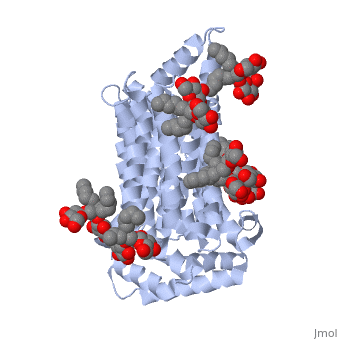Sandbox Reserved 1387
From Proteopedia
(Difference between revisions)
| Line 6: | Line 6: | ||
== Function == | == Function == | ||
The main function of this protein is glucose transmembrane transport. It is one of fourteen facilitative sugar transporters. <ref>https://www.ebi.ac.uk/pdbe/entry/pdb/5c65</ref> | The main function of this protein is glucose transmembrane transport. It is one of fourteen facilitative sugar transporters. <ref>https://www.ebi.ac.uk/pdbe/entry/pdb/5c65</ref> | ||
| - | GLUT3 is categorized as a Class I transporter due to its protein sequence and structural similarity to other glucose transporters grouped in Class I[1]. GLUT3 displays the highest affinity for glucose of all of the Class I glucose transporters and has a transport capacity five times greater than that of GLUT1 and GLUT4[3]. In humans, GLUT3 is found predominantly in brain tissue, highly and specifically expressed by neurons, and has some expression in peripheral tissues. For this reason GLUT3 is commonly known as the “neuronal glucose transporter”[3][4]. GLUT3 has a more restricted expression pathway, which represents specialized functions for the protein[5]. GLUT3 has been found to play an important role in gestational development and maintaining the brain's structure | + | GLUT3 is categorized as a Class I transporter due to its protein sequence and structural similarity to other glucose transporters grouped in Class I[1]. GLUT3 displays the highest affinity for glucose of all of the Class I glucose transporters and has a transport capacity five times greater than that of GLUT1 and GLUT4[3]. In humans, GLUT3 is found predominantly in brain tissue, highly and specifically expressed by neurons, and has some expression in peripheral tissues. For this reason GLUT3 is commonly known as the “neuronal glucose transporter”[3][4]. GLUT3 has a more restricted expression pathway, which represents specialized functions for the protein[5]. GLUT3 has been found to play an important role in gestational development and maintaining the brain's structure. |
== Disease == | == Disease == | ||
| + | Defects in GLUT3 can cause fetal death as well as neurodegeneration, which can lead to diseases like Alzheimer’s. | ||
== Relevance == | == Relevance == | ||
Revision as of 21:55, 22 February 2018
| This Sandbox is Reserved from January through July 31, 2018 for use in the course HLSC322: Principles of Genetics and Genomics taught by Genevieve Houston-Ludlam at the University of Maryland, College Park, USA. This reservation includes Sandbox Reserved 1311 through Sandbox Reserved 1430. |
To get started:
More help: Help:Editing |
Homo sapien Glucose Transporter GLUT3 / SLC2A3
| |||||||||||
References
- ↑ Hanson, R. M., Prilusky, J., Renjian, Z., Nakane, T. and Sussman, J. L. (2013), JSmol and the Next-Generation Web-Based Representation of 3D Molecular Structure as Applied to Proteopedia. Isr. J. Chem., 53:207-216. doi:http://dx.doi.org/10.1002/ijch.201300024
- ↑ Herraez A. Biomolecules in the computer: Jmol to the rescue. Biochem Mol Biol Educ. 2006 Jul;34(4):255-61. doi: 10.1002/bmb.2006.494034042644. PMID:21638687 doi:10.1002/bmb.2006.494034042644
- ↑ https://www.ebi.ac.uk/pdbe/entry/pdb/5c65

